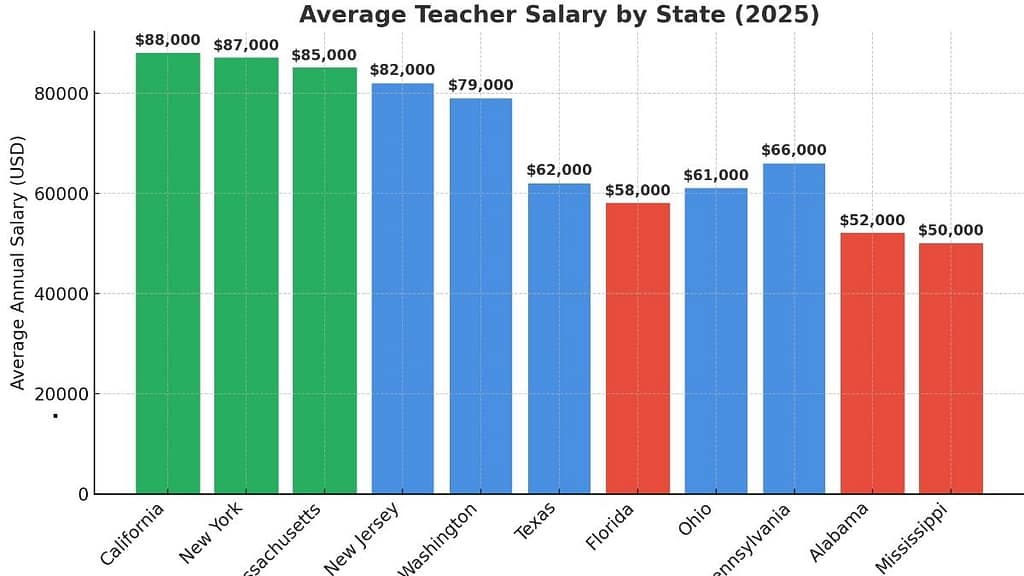Introduction: Teacher Pay in 2025
Teachers are the foundation of education in the United States, shaping future generations while often working long hours inside and outside the classroom. In recent years, teacher pay has become a major topic of debate, with many states introducing reforms to address shortages and improve retention. Understanding the teacher salary by state helps both current educators and those considering the profession make informed decisions about where to teach and what to expect financially.
Average Teacher Salary in the US
According to the National Center for Education Statistics (NCES) and the Bureau of Labor Statistics (BLS), the average teacher salary in the US in 2025 is around $69,000 per year, or about $33 per hour.
However, this average hides wide differences: teachers in states like New York and California can earn well over $85,000 annually, while those in Mississippi and South Dakota may make closer to $50,000.

Teacher Salary by State
Looking at the teacher salary by state, it’s clear that regional differences are significant. States like California, New York, and Massachusetts lead the nation with salaries well above the national average, driven by higher living costs and strong union contracts. On the other hand, states such as Mississippi, Alabama, and South Dakota continue to struggle with lower teacher pay, often making recruitment and retention more difficult. For educators, these differences highlight the importance of considering not just base salary, but also cost of living, benefits, and long-term career opportunities when choosing where to teach.
| State | Average Annual Salary | Hourly Wage | Notes |
|---|---|---|---|
| California | $88,000 | $42.30 | One of the highest-paying states for teachers |
| New York | $87,000 | $41.80 | Strong union presence; high cost of living |
| Massachusetts | $85,000 | $40.90 | High salaries, especially in urban areas |
| New Jersey | $82,000 | $39.40 | Competitive pay and strong benefits |
| Washington | $79,000 | $37.95 | Good pay growth in recent years |
| Illinois | $77,000 | $37.00 | Chicago teachers earn above national average |
| Texas | $62,000 | $29.80 | Big variation between districts |
| Florida | $58,000 | $27.90 | Lower than average; many pay reform debates |
| Ohio | $61,000 | $29.30 | Slightly below national average |
| Pennsylvania | $66,000 | $31.70 | Competitive salaries in larger districts |
| Alabama | $52,000 | $25.00 | Among the lower-paying states |
| Mississippi | $50,000 | $24.00 | One of the lowest teacher salaries in the US |
Highest-paying states: California, New York, Massachusetts, New Jersey
Lowest-paying states: Mississippi, Alabama, South Dakota, Florida
Starting Teacher Salary vs Experienced Teacher Salary
New teachers entering the workforce often earn less than the state average. In 2025, the starting teacher salary by state typically ranges from $42,000 to $50,000 annually. With experience, however, pay increases significantly:
- 1–5 years: $45,000 – $55,000
- 6–10 years: $55,000 – $65,000
- 10+ years: $70,000 – $90,000 depending on the state
Teachers with advanced degrees or certifications also move up the pay scale faster.
Teacher Salary by Education Level
Education makes a difference in earnings. A teacher with a bachelor’s degree may start at $45,000, while one with a master’s degree could earn $55,000 or more in the same district. Some states also reward teachers with PhDs or national board certifications with bonuses or higher pay grades.
Teacher Salary vs Cost of Living
Salary numbers don’t tell the whole story. A teacher earning $80,000 in New York City may struggle more financially than one earning $60,000 in a smaller Midwestern city, where housing costs and daily expenses are much lower. This is why teacher salary vs cost of living is an essential consideration for career planning.
Additional Pay and Benefits for Teachers
Teachers often receive more than just base pay. Common additional compensation includes:
- Summer pay programs or spread-out paychecks over 12 months
- Health insurance and retirement benefits
- Bonuses for shortage subjects (like math and science)
- Overtime or stipends for coaching, tutoring, or extracurricular supervision
These benefits can add thousands of dollars in value each year.

Career Outlook for Teachers
Teaching remains a stable profession with high demand, particularly in STEM fields and special education. The BLS projects steady growth for teacher employment, with some states increasing pay to attract and retain talent. However, ongoing debates about pay equity and funding suggest that teacher salaries will remain a hot topic in the years ahead
The teacher salary by state (2025 updates) shows significant variation across the US. While teachers in states like California, New York, and Massachusetts enjoy some of the highest pay, those in Mississippi and Alabama earn well below the national average. Experience, education level, and cost of living are all key factors in determining whether a teaching salary provides a sustainable and rewarding career path.
Frequently Asked Questions (FAQ)
What state pays teachers the most in 2025?
California and New York lead, with average teacher salaries above $85,000 annually.
What is the average teacher salary in the US?
The national average is about $69,000 in 2025.
Do teachers get paid during the summer?
Yes, many teachers either receive pay spread across 12 months or can opt into summer pay programs.
How do advanced degrees affect teacher pay?
Teachers with master’s or doctoral degrees typically earn $5,000–$15,000 more annually than those with a bachelor’s only.
Which states increased teacher pay in 2025?
Washington, New Jersey, and several southern states implemented reforms to raise teacher salaries this year.

Michael Anderson is a U.S.-based salary and labor market analyst with deep expertise in wage data, career trends, and cost-of-living analysis. At SmartSalaryGuide, he provides reliable, data-driven insights that help readers make informed career and financial decisions. With years of experience studying labor statistics and employment patterns, Michael has developed a reputation for translating complex economic data into clear, actionable guidance. His work empowers professionals, job seekers, and employers alike to better understand the dynamics of today’s job market and plan confidently for the future.

